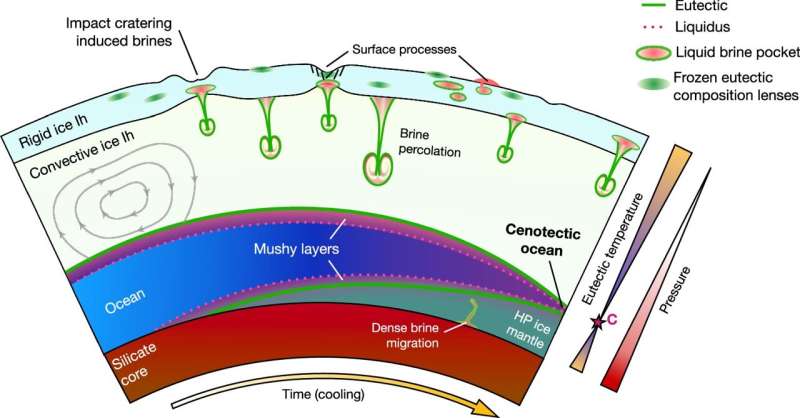
December 19, 2024 by Maddi Busby, Texas A&M University College of Engineering
Collected at: https://phys.org/news/2024-12-cenotectic-concept-redefines-life-icy.html
As NASA’s Europa Clipper embarks on its historic journey to Jupiter’s icy moon, Europa, Dr. Matt Powell-Palm, a faculty member at Texas A&M University’s Department of Mechanical Engineering, has unveiled research that could transform our understanding of icy ocean worlds across the solar system.
The study published in Nature Communications, co-authored with planetary scientist Dr. Baptiste Journaux of the University of Washington, introduces a novel thermodynamic concept called the “cenotectic” and investigates the stability of liquids in extreme conditions—critical information for determining the habitability of icy moons like Europa.
The exploration of icy ocean worlds represents a new frontier in planetary science, focusing on understanding the potential for these environments to support life. Powell-Palm’s research addresses a fundamental question in this field: under what conditions can liquid water remain stable on these distant, frozen bodies?
By defining and measuring the cenotectic, the absolute lowest temperature at which a liquid remains stable under varying pressures and concentrations, the team provides a critical framework for interpreting data from planetary exploration efforts.
This study combines Powell-Palm’s expertise in cryobiology—specifically the low-temperature thermodynamics of water—initially focused on medical applications like organ preservation for transplantation, with Journaux’s expertise in planetary science and high-pressure water-ice systems. Together, they developed a framework that bridges disciplines to tackle one of the most fascinating challenges in planetary science.
“With the launch of NASA Europa Clipper, the largest planetary exploration mission ever launched, we are entering a multi-decade era of exploration of cold and icy ocean worlds. Measurements from this and other missions will tell us how deep the ocean is and its composition,” said Journaux.
“Laboratory measurements of liquid stability, and notably the lowest temperature possible (the newly-defined cenotectic), combined with mission results, will allow us to fully constrain how habitable the cold and deep oceans of our solar system are, and also what their final fate will be when the moons or planets have cooled down entirely.”
The research was conducted at Texas A&M and led by mechanical engineering graduate student Arian Zarriz. The work reflects Texas A&M’s deep expertise in water-ice systems and tradition of excellence in space research, which spans multiple disciplines.
“The study of icy worlds is a particular priority for both NASA and the European Space Agency, as evidenced by the flurry of recent and upcoming spacecraft launches,” said Powell-Palm.
As planetary exploration missions, such as those targeting icy moons, continue to expand our understanding of the solar system, researchers at Texas A&M and beyond prepare to analyze the wealth of data they will provide. By combining experimental studies like those conducted by Powell-Palm and Journaux with the findings from these missions, scientists aim to unlock the secrets of cold, ocean-bearing worlds and evaluate their potential to harbor life.
More information: Arian Zarriz et al, On the equilibrium limit of liquid stability in pressurized aqueous systems, Nature Communications (2024). DOI: 10.1038/s41467-024-54625-z
Journal information: Nature Communications

Leave a Reply